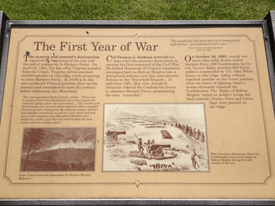Battle of Bolivar Heights
The Battle of Bolivar Heights (October 16, 1861) was an early battle of the American Civil War. Bolivar Heights is a plateau which overlooks the towns of Harpers Ferry, West Virginia and Bolivar, West Virginia, then part of Virginia.[1]
| Battle of Bolivar Heights | |||||||
|---|---|---|---|---|---|---|---|
| Part of American Civil War | |||||||
 Bolivar Heights informational sign, information about the battle on the right. | |||||||
| |||||||
| Belligerents | |||||||
|
|
| ||||||
| Commanders and leaders | |||||||
| John W. Geary[1] | Turner Ashby[1] | ||||||
| Strength | |||||||
| 100 troops[1] | app. 700 troops[1] | ||||||
| Casualties and losses | |||||||
| 4 dead, 7 wounded, 2 taken prisoner[1] | 1 dead, 9 wounded[1] | ||||||
Battle
On October 15, 1861, Union Major General Nathaniel P. Banks ordered Colonel John White Geary to cross the Potomac River from Maryland Heights, part of Elk Ridge (Maryland) and capture wheat stored by the Confederate States Army near Bolivar Heights.[1] Geary crossed the river with 600 men but sent 500 of them back that night.[1] On October 16, a Confederate force of 300 militia men armed with obsolete flintlock muskets, 2 companies of regular Confederate infantrymen and 230 cavalrymen under Colonel Turner Ashby attacked Geary's force, drove them back to Bolivar and nearly surrounded them.[1] The Union force then flanked the inexperienced Confederates and in turn forced them to withdraw.[1] The Union troops captured a Confederate 24-pound cannon that had broken down during the fight.[1] Ashby claimed that he had withdrawn in the face of heavy Union reinforcements after holding his position for four hours.[2] Geary greatly exaggerated the size of the Confederate force (3,000) and the number of casualties his men inflicted on them (about 150).[3] In turn, Ashby exaggerated the Union dead, stating that his men had killed 25 Union soldiers.[2]
Ashby reported that he lost one dead and nine wounded.[3] Geary reported his losses at four dead, seven wounded and two taken prisoner.[3] Geary himself was one of the wounded, having been cut to the bone below the knee by a shell fragment.[4] He stayed on the field despite the wound, from which he recovered quickly.[4]
Notes
- Blair, William Alan and Bell Irvin Wiley. A Politician Goes to War:The Civil War Letters of John White Geary. University Park, PA: Pennsylvania State University, 1995. ISBN 978-0-271-01338-1. p. 18. – via Questia (subscription required)
- Dufour, Charles L. Nine Men in Gray. Lincoln, NE: University of Nebraska Press, 1993. ISBN 978-0-8032-6596-7. p. 53. – via Questia (subscription required) .
- Blair, 1995, p. 19.
- Welsh, Jack D. Medical Histories of Union Generals. Kent, OH: Kent State University Press, 1996. ISBN 978-0-87338-552-7. p. 127. – via Questia (subscription required)
References
- Blair, William Alan and Bell Irvin Wiley. A Politician Goes to War:The Civil War Letters of John White Geary. University Park, PA: Pennsylvania State University, 1995. ISBN 978-0-271-01338-1. – via Questia (subscription required)
- Dufour, Charles L. Nine Men in Gray. Lincoln, NE: University of Nebraska Press, 1993. ISBN 978-0-8032-6596-7. – via Questia (subscription required) .
- Welsh, Jack D. Medical Histories of Union Generals. Kent, OH: Kent State University Press, 1996. ISBN 978-0-87338-552-7. – via Questia (subscription required)
External links
- National Park Service. Quick Facts.
- National Park Service. "Place (U.S. National Park Service)." U.S. Department of the Interior, 8 June 2014. Web. 8 June 2014.